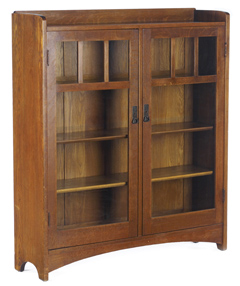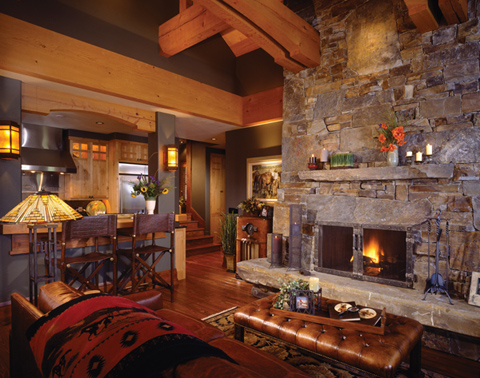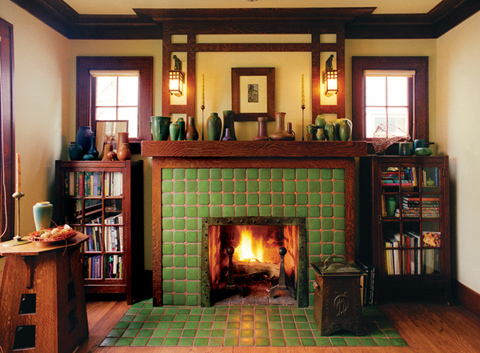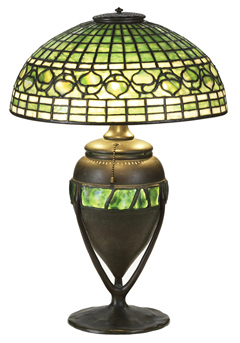The Arts & Crafts movement began in England, the most industrialized country at the time, in the mid-19th century. The founders believed that industrialization was the cause of most societal problems, beginning with the lowest rung, the workers. At the time, manufactured goods were shoddy in both quality and design. Proponents of Arts & Crafts principles believed that good design leads to a good society and that workers should take pride in their craftsmanship and skill. The beautiful objects produced by the craftspeople would then enhance the lives of ordinary people. But ordinary people could not afford to purchase these handcrafted works of art.
By the time the Arts & Crafts movement reached America, it became more democratic in its aims. Americans touted a back-to-basics philosophy that celebrated the joys of a simple life. They embraced any innovations that improved the quality of life, including machine-made products, for the middle class.

As Arts & Crafts spread throughout America, each region developed its own version of architecture and decoration style. Thus, Prairie, Craftsman, Bungalow, and Mission styles are all spinoffs of British Arts & Crafts. Each region’s style reflected its landscape and population; in the U.S. melting pot its influences were Spanish, Mexican, Asian, Gothic, Tudor, and many others.
From the Outside …
Arts & Crafts homes are married to the landscape, and the use of native materials reflects the history of their locales. Many homes are anchored to the property with porches, decks, and patios. Using heavier, square columns gives the structure a sense of stability and permanence. Architectural features such as rooflines and gables were constructed to reflect the landscape of the area. In mountainous areas, the peaks and gables of the roof had a greater pitch and were at differing heights and angles. In the Southwest, low, flat roofs and wide overhangs matched the distant views. Other signature aspects of Arts & Crafts architecture are exposed rafter tails and joinery—Japanese contributions—and wide, welcoming front doors.
Although logs may not have been common in 19th- and early 20th-century Arts & Crafts homes, they blend beautifully with the style’s signature elements and overall philosophy. You can bring out the Arts & Crafts flavor by adding shingles or stucco at the eaves and building substantial columns to support exposed beams over the doorway. Light fixtures will go a long way to hinting at your Arts & Crafts-style interior, as will adding a stained glass window, a simple carved front door, and metal hardware. Timber frame homes begin with an exposed wood structure and visible joinery, and they lend themselves to just about any exterior material, from stone to stucco to log. With the right accents, it is easy to style a timber frame home in Arts & Crafts fashion.

Locati Architects & SBC, Inc./photo by Roger Wade Studio
… Looking In
Arts & Crafts designers and architects aimed to improve not only the building construction but also the lives of the inhabitants. While the Victorians relied on formal etiquette and social rituals, leading to overly ornate homes separated into single-purpose, closed-off rooms, the Arts & Crafts movement encouraged family unity and communication. To accomplish this, the walls came down and a new concept was born: the open floorplan! The open floorplan was important for family unity, but it also allowed the décor to flow into all areas of the home. Instead of walls, different areas were defined with area rugs and furniture groupings or varying ceiling heights. An open floorplan, along with higher ceilings and larger windows, made the homes seem larger and joined the interior with the outdoor landscape.
The Arts & Crafts interior was designed for beauty, function, and longevity. High-quality woodwork graced the walls and door and window trim, often depicting a stylized natural element such as clouds, flowers, or trees that created further harmony from space to space. To add to the function, save space, and streamline the living space, built-ins were used extensively. Window seats, display shelves, and cabinetry constructed of native woods hid clutter and kept the home’s lines simple and clean.

The Hearth of the Home
As in today’s log and timber frame homes, the Arts & Crafts fireplace is both a focal point and a place of welcome and communication. Local stones were commonly used to tie the interior to the outdoors; stucco and brick were also used. To promote conversation, many Arts & Crafts home feature an Inglenook with built-in seating for small gatherings around the extended hearth. Decorative metal hoods and exquisite tile surrounds in colors drawn from nature grace many Arts & Crafts fireplaces. A broad mantel is an ideal place to display artwork or pottery from the period.
In the Kitchen
Kitchens in the early 20th century were not the showplaces that they are in most homes today. There were far fewer appliances so the rooms were small relative to the rest of the home. Space-saving, built-in cabinets were joined by furniture pieces, such as Hoosier cabinets or tables, which served as workstations. Cabinets were constructed of natural wood or painted in subdued natural colors. Arts & Crafts-style cabinets are readily available today, but a simple Shaker-style cabinet will work equally well in a modern kitchen. Metal range hoods in a hammered copper or pewter to match stylized hardware increase the kitchen’s Arts & Crafts appeal. The backsplash is the ideal place for some gorgeous Arts & Crafts tile. A number of American clay artists create beautiful tile in keeping with the motifs and colors of the period.

Photos courtesy of Motawi Tileworks
Stylizing Nature
All Arts & Crafts designs and colors reflect a reverence for nature. Artists transformed a three-dimensional pattern into a stylized design of lines and colors. These “flattened” motifs were used in rugs, pottery, metalwork, and fabrics. Wallpaper, borders, and stenciling were commonly used throughout the home as a way to unify the decor. The choice of colors also flowed from room to room; colors included muted buff, tan, rose, gold, green, blue, and burgundy, but any colors can be used in a modern home to create a unity of design.
Arts & Crafts furniture design is also rooted in nature, taking on plant, animal, or environmental forms. Each region of the country developed its own version, ranging from stark, more basic Mission to the more ornate, curvilinear Art Nouveau. No matter its name, furniture was designed to be sturdy, practical, and beautiful. Furniture style was influenced by Shaker simplicity and straight lines. American furniture makers such as Stickley and Roycroft embraced machine-made furniture because it was relatively inexpensive, functional, substantial, and attractive. Once the basic furniture piece was produced, it was embellished with leather, carving, and metal. However, the wood grain was the key design element. Most original Arts & Crafts furniture is in museums or in the collections of private collectors, but Stickley is still in the business of producing fine furniture. A number of furniture makers today are putting their own spin on Arts & Crafts style.

Lighting the Way
Lighting is an essential part of Arts & Crafts style and is the easiest way to bring the style into your log or timber frame home. In the early 20th century, lamps and other fixtures were designed to reduce the harsh glare of electric lights. Shades made of mica, stained glass, or colored blown glass filtered the light and gave the rooms a magical glow. A variety of light fixtures were used throughout the home, almost always in odd numbers. Lighting was designed to be welcoming and flattering to guests and homeowners, in keeping with Arts & Crafts principles. Arts & Crafts-style lighting is available from numerous sources in every price range. Skilled artists are also creating museum-worthy light fixtures.
Arts & Crafts style is perhaps the most versatile because of its many cultural influences. Unless you are restoring a 1910 bungalow or building an authentic Arts & Crafts, Mission, or Prairie home, you will want to mix in other styles. Arts & Crafts furniture and décor are equally compatible with Western, Shaker, Asian, and modern elements. Just keep it simple, practical, and informal and use “honest” materials and you’ll be halfway there. The British founders of the Arts & Crafts movement were rebelling against the dirt, noise, and poor workmanship of the Industrial Age. Today, lovers of log and timber frame homes are seeking their own refuge from an overcomplicated, technology-ridden lifestyle.

